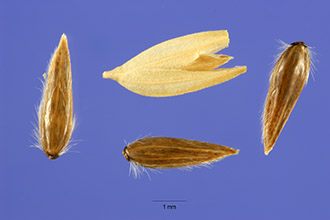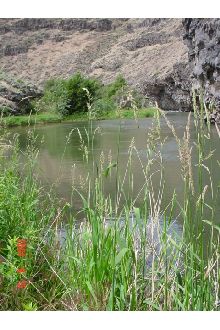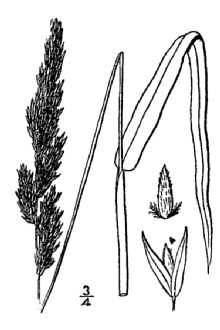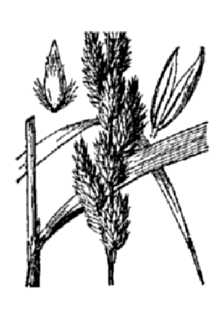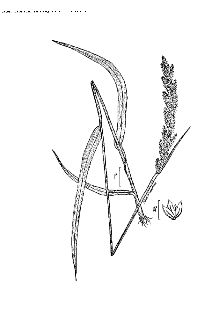Phalaroides arundinacea (L.) Raeusch.
Scientific Name: Phalaroides arundinacea (L.) Raeusch.
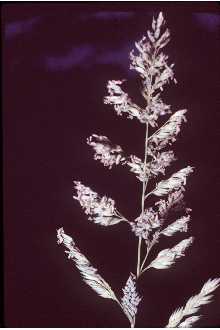
| General Information | |
|---|---|
| Usda Symbol | PHAR15 |
| Group | Monocot |
| Life Cycle | Perennial |
| Growth Habits | Graminoid |
| Native Locations | PHAR15 |
Plant Guide
Alternate Names
gardener's-garters (Source: Hortus 3 ), reed Canary grass (Source: World Econ Pl ), ribbon grass (Source: Dict Gard ), variegated grass (Source: Webster's Dict ), alpiste roseau (Source: Dict Rehm ) [French], Rohrglanzgras (Source: Dict Rehm ) [German], kusayoshi (Source: F Japan Ohwi) [Japanese], caniçomalhado (Source: Dict Rehm ) [Portuguese], hierba cinta (Source: Dict Rehm ) [Spanish], pasto cinto (Source: Dict Rehm ) [Spanish] (USDA, ARS 2002) , Use soil moisture sensors to measure the soil moisture of Phalaroides arundinacea (L.) Raeusch..
Uses
Use of reed canarygrass in the Pacific Northwest basically began at the turn of the century. Farming commonly followed logging operations and reed canarygrass was frequently used as the “breaking in” crop (Wheeler 1950). Stumps & logging debris and clearing operations left the land unsuitable for planting crops such as small grains. Reed canarygrass was planted in these areas to allow time for the stumps and debris to degrade and be more easily removed at a later date. Reed canarygrass popularity in the Pacific Northwest was a composite of many factors. It is an extremely productive grass. Reports of production far exceeding other grasses are common in the early literature. It is very easy to establish and it persists very well. Most plantings occurred during a period of history when farms were more self-reliant. Livestock were pastured on the farm, and hay was grown on the farm rather than purchased from hay brokers. It was a reliable, productive forage. A second wave of interest in reed canarygrass occurred when wastewater management became an important issue. Reed canarygrass has the ability to respond exceedingly well to applied nutrients and one study showed a yield response to levels as high as 920 pounds N/acre (Schmitt et al. 1999). Zeiders (1976) reported, “reed canarygrass is the most popular species for irrigation with wastewater from municipal and industrial sources as a pollution control measure”. The most recent wave of interest in reed canarygrass is occurring in Europe. Reed canarygrass is being cultivated in northern Europe as a biofuel and about 10,000 acres are in production in Scandinavia (Kätterer et al (1998). It is a plant with many uses. Unfortunately, reed canarygrass has proven to be too aggressive in the Pacific Northwest. It moves out of pastureland and into stream bottoms, wetlands, and canal banks. It persists in areas where it is not desirable and is the bane of wetland restoration.
Status
Please consult the PLANTS Web site and your State Department of Natural Resources for this plant’s current status (e.g. threatened or endangered species, state noxious status, and wetland indicator values).
Weediness
This plant may become weedy or invasive in some regions or habitats and may displace desirable vegetation if not properly managed. Please consult with your local NRCS Field Office, Cooperative Plant Materials <http://plant-materials.nrcs.usda.gov/> Plant Fact Sheet/Guide Coordination Page <http://plant-materials.nrcs.usda.gov/intranet/pfs.html> National Plant Data Center <http://npdc.usda.gov>
Description
Reed canarygrass is 2-9 feet tall non-native with flat, rough-textured, tapering leaves from 31/2-10 inches long. The stem is hairless and stands erect. One of the first grasses to sprout in the spring, reed canary grass produces a compact panicle 3-16 inches long that is erect or slightly spreading. The flowers are green to purple early in the season and change to beige over time. The grass forms a thick rhizome system that quickly dominates the soil. There is some debate as to the origin of the species. Sources document native and non-native genotypes of reed canary grass. The non-native strain is thought to be more invasive than native strain. Distribution: For current distribution, please consult the Plant Profile page for this species on the PLANTS Web site.
Adaptation
Growth of reed canarygrass begins early in the spring, senescence occurs with summer drought, and limited vegetative growth resumes in the fall if moisture is available. Sprouts will frequently be seen growing in ephemeral ponded water in the spring. Carbohydrate reserves stored in the rhizomes fuel the growth of these sprouts (Hovin et al. 1973). The roots are not contributing to the growth in this situation because the ponding causes an anaerobic condition. If the water remains on the stand for a prolonged period the roots will eventually die because the reducing environment will not only deprive roots of oxygen but will also remove oxygen from the roots. The culms are very tall and individual leaves grow from nodes along the culm. The leaves of the lower culm become light deprived as the plant grows and are replaced with new leaves higher up the culm. If the stand is cut, new leaves will sprout from either rhizomes or from exposed nodes on the shortened culm. Biomass production is exceedingly high (as high as 9 tons/acre) but it requires a tremendous amount of nutrients to sustain this growth. Riparian soils tend to be very rich in nutrients, allowing reed canarygrass to thrive. Limiting its growth by removing nutrients has not been practical on a field scale. Indeed, there are stands that are hayed every year and a large amount of nutrients subsequently removed, and yet these stands continue to proliferate for decades. Reed canarygrass is very competitive once established and will frequently develop a solid monoculture. Tall growth enables reed canarygrass to compete with other herbaceous species by depriving them of light. Native herbaceous species that initiate growth late in the spring are especially impacted by reed canarygrass.
Establishment
Rhizomes account for much of the localized spread of reed canarygrass. Rhizomes grow outwardly from a mother plant until the terminal bud develops a shoot (Evans and Ely 1941). This is unlike quackgrass, which develops shoots all along the rhizome axis. This allows reed canarygrass to rapidly expand its local territory and a single rhizome or stem can infest an entire drainage. Reed canarygrass culms are also capable of rooting and establishing stands (Hovin et al. 1973). Hovin and his coworkers reported that the nodes of reed canarygrass culms become meristematically active once the panicles are removed, and stage of development of the panicle affected the percent survival of the new plants. Pre-anthesis culms rooted poorly while culms from post-anthesis plants rooted better. Bank erosion and transport of culms allows for yet another means of establishing plants along a watercourse.
Management
Seeds require several days at cool temperatures for a high percentage of the seeds to germinate. The rate and amount of germination is typical for most cool season pasture grasses, but pales in comparison to many annual weeds. For comparison, yellow starthistle and cheatgrass can achieve 75% germination within 2 days. Seedling development of reed canarygrass is similar to other cool season pasture grasses. The seedlings lack vigor and are very sensitive to competition. Morrison and Molofsky (1998, 1999) reported that reed canarygrass seedlings were more sensitive to interspecific competition then they were to decreased water availability.
Pests and Potential Problems
Reed canarygrass is a classic weed in many environments but in environments subject to frequent & severe disturbances it has some value. It persists very well in spite of grazing. The grazing period lasts nine months west of the Cascades (Wheeler
Environmental Concerns
Concerns
Concerns
It is a plant with many uses. Unfortunately, reed canarygrass has proven to be too aggressive in the Pacific Northwest. It moves out of pastureland and into stream bottoms, wetlands, and canal banks. It persists in areas where it is not desirable and is the bane of wetland restorationists.
Seeds and Plant Production
Plant Production
Plant Production
Reed canarygrass seed is quite small, very dense, and resembles timothy seed because both are small, heavy, and naked. Fully sodded stands produce only 30-50 pounds seed/acre (Schoth 1938). Old stands tend to have a higher proportion of vegetative culms than reproductive culms. Seed heads are borne on long culms and seeds mature from the top of the head down. Fully ripe seeds are highly viable and shatter readily. Indeterminate maturation allows for a prolonged period of seed dispersal, which reduces seed predation. It also increases the chances of some seed being dispersed by an episodic event such as an animal brushing against a plant and some seed catching in its coat. Rhizomes account for much of the localized spread of reed canarygrass. Rhizomes grow outwardly from a mother plant until the terminal bud develops a shoot (Evans and Ely 1941). This is unlike quackgrass, which develops shoots all along the rhizome axis. This allows reed canarygrass to rapidly expand its local territory and a single rhizome or stem can infest an entire drainage.
Control
Please contact your local agricultural extension specialist or county weed specialist to learn what works best in your area and how to use it safely. Always read label and safety instructions for each control method. Trade names and control measures appear in this document only to provide specific information. USDA, NRCS does not guarantee or warranty the products and control methods named, and other products may be equally effective. Cultivars, Improved, and Selected Materials (and area of origin) These plant materials are readily available from commercial sources. Contact your local Natural Resources Conservation Service (formerly Soil Conservation Service) office for more information. Look in the phone book under ”United States Government.” The Natural Resources
Conservation
Service will be listed under the subheading “Department of Agriculture.”
Fact Sheet
Uses
Erosion control: The extensive, rhizomatous root system and dense growth of reed canarygrass provide excellent erosion control, especially along stream banks, shorelines and waterways, Reed canarygrass invades wet areas so its use along ditches, canals and drains can create maintenance problems; it can also be troublesome in wetland habitats, Filter fields: Reed canarygrass is a heavy user of fertilizer and actively grows throughout a long season, Because of this and its excellent adaptation to wet sites, it is well suited for use in seeding filter fields which collect wastewater from food processing industries, livestock operations, and sewage treatment plants, Cutting and removal of biomass is required for good nutrient uptake performance, but a 6 to 8 inch cut height is recommended for rapid regrowth under these conditions, Any forage produced can be used for livestock feed, Forage: Reed canarygrass is primarily adapted for permanent hay or pasture on sites too wet for good performance of other forage plants, The forage should be grazed or mowed prior to heading as both quality and palatability decline rapidly after heading, Use soil moisture sensors to measure the soil moisture of Phalaroides arundinacea (L.) Raeusch.., A common mistake is to use reed canarygrass on wet sites where timely harvest is not possible, Wildlife: This grass provides excellent nesting and escape cover and the shattered seeds are readily eaten by many species of birds,
Status
Please consult the PLANTS Web site and your State Department of Natural Resources for this plant’s current status (e.g. threatened or endangered species, state noxious status, and wetland indicator values).
Weediness
This plant may become weedy or invasive in some regions or habitats and may displace desirable vegetation if not properly managed. Please consult with your local NRCS Field Office, Cooperative Extension Service office, or state natural resource or agriculture department regarding its status and use. Weed information is also available from the PLANTS Web site at plants.usda.gov. Robert H. Mohlenbrock USDA NRCS 1991 Southern Wetland Flora @ USDA NRCS PLANTS
Description
Phalaris arundinacea L., reed canarygrass, is a vigorous, productive, long-lived, perennial, sod- forming grass. It is a widespread species native to North America, Europe, and Asia. The numerous broad, moderately harsh, erect leaves are dominantly basal. The coarse, erect stems may reach a height of 6 to 8 feet. Seed is borne in an open panicle which ripens from the top down and shatters readily as it matures. The seed has a short storage life, up to 5 years, and should be checked for germination within 6 months of its use. Reed canarygrass has excellent frost tolerance and is well suited to wet soils that are poorly drained or subject to flooding. It also has good drought tolerance. Growth begins in early spring and continues through the growing season. Regrowth following mowing or grazing is rapid on fertile sites. Forage quality is good prior to heading but then declines rapidly.
Adaptation and Distribution
Distribution
Distribution
Reed canarygrass is adapted to soils too wet for bromegrass, fescue, and orchardgrass. It is very cold tolerant and will withstand temperatures well below -30 °F. It is moderately drought tolerant but requires 18 inches annual precipitation or irrigation for good performance. It is adapted to a wide range of soil conditions but its major use is on poorly drained soils or those subject to inundation. Once established, it will withstand continuous inundation for 60 to 70 days. It does well on soils that range from moderately acidic to weakly saline-alkaline. It will tolerate saltier soils with frequent irrigation or natural flooding. Reed canarygrass is distributed throughout the west, north, and northeastern United States. For a current distribution map, please consult the Plant Profile page for this species on the PLANTS Website.
Establishment
A firm, moist, clean seedbed is needed for good emergence. Old fields or meadows should be cropped to annual crops for 1 to 2 years to eliminate perennial weeds, grasses and sedges before seeding reed canarygrass. The seed germinates readily but is somewhat slow to establish. Seed in pure stands at a rate of 5 to 7 pounds per acre. Seeding should be done in late fall or early spring. Plant shallow, no deeper than 1/2 inch. If necessary, irrigate to maintain surface moisture until plants are well established.
Management
New seedings should not be grazed until fully established. It is best to harvest for hay one to two times before grazing. To maintain plant vigor and promote rapid regrowth, leave a stubble of 6 inches after mowing or grazing. Start spring grazing after plants reach a height of 10 to 12 inches. Harvest hay when the first seedheads appear. Reed canarygrass will persist under close, frequent use but yield will be greatly reduced. Its persistence under heavy use does make it well suited for calving, lambing, holding areas or other special-use pastures. To maintain good yields an annual application of nitrogen will be required on most sites.
Pests and Potential Problems
The leaf disease Helminthosporium giganteum sometimes attacks reed canarygrass and work in Pennsylvania led to the discovery of the disease tawny blotch (Stagonospora foliicola) on this plant. Cultivars, Improved, and Selected Materials (and area of origin) Improved cultivars and places of development are ‘Castor’, ‘Grove’, ‘Rival’ (Canada) and ‘Ioreed’, ‘Palaton’, ‘R.P. 200’, ‘Vantage’, ‘Venture’ (Iowa). ‘Palaton’, ‘Rival’, and ‘Venture’ are low alkaloid-containing cultivars and are greatly preferred for all uses in the Northeast. Common types of reed canarygrass are available from most commercial sources.
Plant Traits
Growth Requirements
| Fire Tolerance | High |
|---|---|
| Cold Stratification Required | No |
| Cold Stratification Required | No |
| Drought Tolerance | Low |
| Drought Tolerance | Low |
| Drought Tolerance | Medium |
| Drought Tolerance | Medium |
| Drought Tolerance | Medium |
| Fertility Requirement | High |
| Fertility Requirement | High |
| Fertility Requirement | High |
| Fertility Requirement | High |
| Fertility Requirement | High |
| Fire Tolerance | High |
| Cold Stratification Required | No |
| Fire Tolerance | Medium |
| Fire Tolerance | Medium |
| Fire Tolerance | Medium |
| Frost Free Days, Minimum | 100 |
| Frost Free Days, Minimum | 120 |
| Frost Free Days, Minimum | 120 |
| Frost Free Days, Minimum | 120 |
| Frost Free Days, Minimum | 160 |
| Hedge Tolerance | None |
| Hedge Tolerance | None |
| Hedge Tolerance | None |
| Hedge Tolerance | None |
| Hedge Tolerance | None |
| Adapted to Medium Textured Soils | Yes |
| Adapted to Coarse Textured Soils | No |
| Adapted to Coarse Textured Soils | No |
| Adapted to Coarse Textured Soils | Yes |
| Adapted to Coarse Textured Soils | Yes |
| Adapted to Coarse Textured Soils | Yes |
| Adapted to Fine Textured Soils | Yes |
| Adapted to Fine Textured Soils | Yes |
| Adapted to Fine Textured Soils | Yes |
| Adapted to Fine Textured Soils | Yes |
| Adapted to Fine Textured Soils | Yes |
| Adapted to Medium Textured Soils | Yes |
| Adapted to Medium Textured Soils | Yes |
| Adapted to Medium Textured Soils | Yes |
| Temperature, Minimum (°F) | -38 |
| Adapted to Medium Textured Soils | Yes |
| Anaerobic Tolerance | High |
| Anaerobic Tolerance | High |
| Anaerobic Tolerance | High |
| Anaerobic Tolerance | High |
| Anaerobic Tolerance | High |
| CaCO3 Tolerance | Medium |
| CaCO3 Tolerance | Medium |
| CaCO3 Tolerance | Medium |
| CaCO3 Tolerance | Medium |
| CaCO3 Tolerance | Medium |
| Cold Stratification Required | No |
| Cold Stratification Required | No |
| Salinity Tolerance | Medium |
| Precipitation, Maximum | 65 |
| Precipitation, Maximum | 65 |
| Precipitation, Minimum | 30 |
| Precipitation, Minimum | 30 |
| Precipitation, Minimum | 30 |
| Precipitation, Minimum | 32 |
| Precipitation, Minimum | 35 |
| Root Depth, Minimum (inches) | 14 |
| Root Depth, Minimum (inches) | 14 |
| Root Depth, Minimum (inches) | 14 |
| Root Depth, Minimum (inches) | 14 |
| Root Depth, Minimum (inches) | 14 |
| Salinity Tolerance | Medium |
| Moisture Use | High |
| Salinity Tolerance | Medium |
| Salinity Tolerance | Medium |
| Salinity Tolerance | Medium |
| Shade Tolerance | Intolerant |
| Shade Tolerance | Intolerant |
| Shade Tolerance | Intolerant |
| Shade Tolerance | Intolerant |
| Shade Tolerance | Intolerant |
| Temperature, Minimum (°F) | -32 |
| Temperature, Minimum (°F) | -33 |
| Temperature, Minimum (°F) | -33 |
| Temperature, Minimum (°F) | -33 |
| Precipitation, Maximum | 60 |
| Moisture Use | High |
| Moisture Use | High |
| Moisture Use | High |
| Moisture Use | High |
| pH, Maximum | 8.0 |
| pH, Maximum | 8.0 |
| pH, Maximum | 8.2 |
| pH, Maximum | 8.2 |
| pH, Maximum | 8.2 |
| pH, Minimum | 4.9 |
| pH, Minimum | 4.9 |
| pH, Minimum | 4.9 |
| pH, Minimum | 5.5 |
| Planting Density per Acre, Maxim | 4800 |
| Precipitation, Maximum | 60 |
| Precipitation, Maximum | 60 |
| Planting Density per Acre, Minim | 2700 |
| Planting Density per Acre, Minim | 2700 |
| Planting Density per Acre, Minim | 2700 |
| Planting Density per Acre, Minim | 2700 |
| Planting Density per Acre, Minim | 2700 |
| Planting Density per Acre, Maxim | 4800 |
| Planting Density per Acre, Maxim | 4800 |
| Planting Density per Acre, Maxim | 4800 |
| Planting Density per Acre, Maxim | 4800 |
| pH, Minimum | 5.5 |
Morphology/Physiology
| Active Growth Period | Spring, Summer, Fall |
|---|---|
| Toxicity | Slight |
| Toxicity | Slight |
| Toxicity | Slight |
| Toxicity | Slight |
| Toxicity | Slight |
| Shape and Orientation | Erect |
| Shape and Orientation | Erect |
| Shape and Orientation | Erect |
| Shape and Orientation | Erect |
| Foliage Color | Green |
| Fire Resistant | No |
| Fire Resistant | No |
| Fire Resistant | No |
| Fire Resistant | No |
| Fire Resistant | No |
| Flower Color | Yellow |
| Flower Color | Yellow |
| Flower Color | Yellow |
| Flower Color | Yellow |
| Flower Color | Yellow |
| Flower Conspicuous | No |
| Flower Conspicuous | No |
| Flower Conspicuous | No |
| Flower Conspicuous | No |
| Flower Conspicuous | No |
| Fall Conspicuous | No |
| Foliage Color | Green |
| Foliage Color | Green |
| Foliage Color | Green |
| Foliage Color | Green |
| Foliage Porosity Summer | Dense |
| Foliage Porosity Summer | Dense |
| Foliage Porosity Summer | Dense |
| Foliage Porosity Summer | Dense |
| Foliage Porosity Summer | Dense |
| Foliage Porosity Winter | Moderate |
| Foliage Porosity Winter | Moderate |
| Foliage Porosity Winter | Porous |
| Foliage Porosity Winter | Porous |
| Foliage Porosity Winter | Porous |
| Bloat | None |
| Shape and Orientation | Erect |
| Active Growth Period | Spring, Summer, Fall |
| Active Growth Period | Spring, Summer, Fall |
| Active Growth Period | Spring, Summer, Fall |
| Active Growth Period | Spring, Summer, Fall |
| After Harvest Regrowth Rate | Moderate |
| After Harvest Regrowth Rate | Moderate |
| After Harvest Regrowth Rate | Moderate |
| After Harvest Regrowth Rate | Moderate |
| After Harvest Regrowth Rate | Moderate |
| Bloat | None |
| Bloat | None |
| Bloat | None |
| Bloat | None |
| Resprout Ability | No |
| C:N Ratio | Medium |
| C:N Ratio | Medium |
| C:N Ratio | Medium |
| C:N Ratio | Medium |
| C:N Ratio | Medium |
| Coppice Potential | No |
| Coppice Potential | No |
| Coppice Potential | No |
| Coppice Potential | No |
| Coppice Potential | No |
| Fall Conspicuous | No |
| Fall Conspicuous | No |
| Fall Conspicuous | No |
| Fall Conspicuous | No |
| Lifespan | Long |
| Known Allelopath | No |
| Known Allelopath | No |
| Known Allelopath | No |
| Known Allelopath | No |
| Known Allelopath | No |
| Leaf Retention | No |
| Leaf Retention | No |
| Leaf Retention | No |
| Leaf Retention | No |
| Leaf Retention | No |
| Lifespan | Long |
| Lifespan | Long |
| Lifespan | Long |
| Lifespan | Long |
| Foliage Texture | Coarse |
| Low Growing Grass | Yes |
| Low Growing Grass | Yes |
| Low Growing Grass | Yes |
| Low Growing Grass | Yes |
| Low Growing Grass | Yes |
| Nitrogen Fixation | None |
| Nitrogen Fixation | None |
| Nitrogen Fixation | None |
| Nitrogen Fixation | None |
| Nitrogen Fixation | None |
| Resprout Ability | No |
| Resprout Ability | No |
| Resprout Ability | No |
| Resprout Ability | No |
| Height, Mature (feet) | 6.0 |
| Height, Mature (feet) | 6.0 |
| Foliage Texture | Coarse |
| Foliage Texture | Coarse |
| Foliage Texture | Coarse |
| Foliage Texture | Coarse |
| Fruit/Seed Color | Black |
| Fruit/Seed Color | Black |
| Fruit/Seed Color | Brown |
| Fruit/Seed Color | Brown |
| Fruit/Seed Color | Brown |
| Fruit/Seed Conspicuous | No |
| Fruit/Seed Conspicuous | No |
| Fruit/Seed Conspicuous | No |
| Fruit/Seed Conspicuous | No |
| Growth Form | Rhizomatous |
| Fruit/Seed Conspicuous | No |
| Height, Mature (feet) | 6.0 |
| Height, Mature (feet) | 5.0 |
| Height, Mature (feet) | 5.0 |
| Growth Rate | Rapid |
| Growth Rate | Rapid |
| Growth Rate | Rapid |
| Growth Rate | Rapid |
| Growth Form | Rhizomatous |
| Growth Form | Rhizomatous |
| Growth Form | Rhizomatous |
| Growth Form | Rhizomatous |
| Growth Rate | Rapid |
Reproduction
| Propagated by Sod | No |
|---|---|
| Propagated by Sprigs | Yes |
| Propagated by Sprigs | Yes |
| Propagated by Sprigs | Yes |
| Propagated by Sprigs | Yes |
| Propagated by Sprigs | Yes |
| Propagated by Tubers | No |
| Propagated by Tubers | No |
| Propagated by Tubers | No |
| Propagated by Tubers | No |
| Propagated by Tubers | No |
| Seed per Pound | 537920 |
| Propagated by Sod | No |
| Propagated by Sod | No |
| Propagated by Sod | No |
| Propagated by Sod | No |
| Propagated by Seed | Yes |
| Propagated by Seed | Yes |
| Propagated by Seed | Yes |
| Propagated by Seed | Yes |
| Propagated by Seed | Yes |
| Propagated by Cuttings | No |
| Propagated by Cuttings | No |
| Propagated by Cuttings | No |
| Propagated by Cuttings | No |
| Seedling Vigor | Medium |
| Vegetative Spread Rate | Rapid |
| Vegetative Spread Rate | Rapid |
| Vegetative Spread Rate | Rapid |
| Vegetative Spread Rate | Rapid |
| Vegetative Spread Rate | Rapid |
| Small Grain | No |
| Small Grain | No |
| Small Grain | No |
| Small Grain | No |
| Small Grain | No |
| Seedling Vigor | Medium |
| Seedling Vigor | Medium |
| Seed per Pound | 537920 |
| Seedling Vigor | Low |
| Seedling Vigor | Low |
| Seed Spread Rate | Slow |
| Seed Spread Rate | Slow |
| Seed Spread Rate | Rapid |
| Seed Spread Rate | Rapid |
| Seed Spread Rate | Moderate |
| Seed per Pound | 537920 |
| Seed per Pound | 537920 |
| Fruit/Seed Period End | Summer |
| Seed per Pound | 537920 |
| Fruit/Seed Abundance | Medium |
| Fruit/Seed Period End | Summer |
| Fruit/Seed Period End | Summer |
| Fruit/Seed Period End | Summer |
| Fruit/Seed Period End | Summer |
| Fruit/Seed Period Begin | Summer |
| Fruit/Seed Period Begin | Summer |
| Fruit/Seed Period Begin | Summer |
| Fruit/Seed Period Begin | Spring |
| Fruit/Seed Period Begin | Spring |
| Fruit/Seed Abundance | Medium |
| Fruit/Seed Abundance | Medium |
| Fruit/Seed Abundance | Medium |
| Propagated by Corm | No |
| Fruit/Seed Abundance | Low |
| Commercial Availability | Routinely Available |
| Commercial Availability | Routinely Available |
| Commercial Availability | Routinely Available |
| Commercial Availability | Routinely Available |
| Commercial Availability | Routinely Available |
| Bloom Period | Late Spring |
| Bloom Period | Late Spring |
| Bloom Period | Late Spring |
| Bloom Period | Late Spring |
| Bloom Period | Late Spring |
| Propagated by Cuttings | No |
| Fruit/Seed Persistence | No |
| Fruit/Seed Persistence | No |
| Propagated by Corm | No |
| Propagated by Corm | No |
| Propagated by Corm | No |
| Propagated by Corm | No |
| Propagated by Container | No |
| Propagated by Container | No |
| Propagated by Container | No |
| Propagated by Container | No |
| Propagated by Container | No |
| Propagated by Bulb | No |
| Propagated by Bulb | No |
| Propagated by Bulb | No |
| Propagated by Bulb | No |
| Fruit/Seed Persistence | No |
| Fruit/Seed Persistence | No |
| Fruit/Seed Persistence | No |
| Propagated by Bare Root | No |
| Propagated by Bare Root | No |
| Propagated by Bare Root | No |
| Propagated by Bare Root | No |
| Propagated by Bare Root | No |
| Propagated by Bulb | No |
Suitability/Use
| Post Product | No |
|---|---|
| Post Product | No |
| Post Product | No |
| Post Product | No |
| Palatable Human | No |
| Palatable Human | No |
| Palatable Human | No |
| Palatable Human | No |
| Palatable Human | No |
| Palatable Graze Animal | Medium |
| Palatable Graze Animal | Medium |
| Palatable Graze Animal | Medium |
| Palatable Graze Animal | Medium |
| Palatable Graze Animal | High |
| Palatable Browse Animal | Medium |
| Palatable Browse Animal | Low |
| Post Product | No |
| Protein Potential | Medium |
| Protein Potential | Medium |
| Protein Potential | Medium |
| Protein Potential | Medium |
| Protein Potential | Medium |
| Pulpwood Product | No |
| Pulpwood Product | No |
| Pulpwood Product | No |
| Pulpwood Product | No |
| Pulpwood Product | No |
| Veneer Product | No |
| Veneer Product | No |
| Veneer Product | No |
| Veneer Product | No |
| Veneer Product | No |
| Christmas Tree Product | No |
| Lumber Product | No |
| Fodder Product | Yes |
| Fodder Product | Yes |
| Fodder Product | Yes |
| Fodder Product | Yes |
| Fodder Product | Yes |
| Christmas Tree Product | No |
| Christmas Tree Product | No |
| Lumber Product | No |
| Christmas Tree Product | No |
| Christmas Tree Product | No |
| Berry/Nut/Seed Product | No |
| Berry/Nut/Seed Product | No |
| Berry/Nut/Seed Product | No |
| Berry/Nut/Seed Product | No |
| Berry/Nut/Seed Product | No |
| Palatable Browse Animal | Low |
| Lumber Product | No |
| Lumber Product | No |
| Lumber Product | No |
| Naval Store Product | No |
| Naval Store Product | No |
| Naval Store Product | No |
| Naval Store Product | No |
| Naval Store Product | No |
| Nursery Stock Product | No |
| Nursery Stock Product | No |
| Nursery Stock Product | No |
| Nursery Stock Product | No |
| Nursery Stock Product | No |
| Palatable Browse Animal | Low |
| Palatable Browse Animal | Low |

